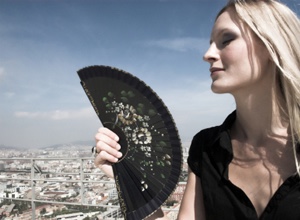7 Possible Triggers of Hot Flushes
Do you know what makes your flushes start? Could one of these be the answer?

I can’t stress enough that you are an individual, and so are your symptoms which means that not everyone has the same experience.
You may experience a different intensity or severity, or how long they last, but what sets off one woman’s hot flushes and night sweats may have zero effect on another.
The easiest way to spot your personal triggers is to keep track of your activities and symptoms in a journal or diary or on your phone. When the flush occurs keep a record of what you are doing, what you ate, and drank before or during a flush.
This way you’ll notice a pattern between what you do and how you feel when experiencing a flush.
1. Stress
In my experience this is by far and away the most common cause as feeling overwhelmed, anxious, or stressed can definitely trigger hot flushes.
Unfortunately stress is not easy to avoid but if you know certain situations make you anxious then explore using relaxation techniques like meditation, deep breathing, and guided imagery.
I personally have always found acupuncture and homoeopathy great helps for reducing anxiety as is listening to relaxing music and sharing your concerns with a friend or a professional with counselling or hypnotherapy.
2. Spicy foods
Diet is generally an important factor in good health, but what you eat can also make a difference to your flushes.
A simple thing you can do is to watch the heat level in what you eat as spicy food is a common culprit. Try to avoid food, sauces, and drinks with a kick, whether that’s Indian or Thai food or just heat from chilli peppers.
Watch what you drink too as it’s not just spices that can trigger symptoms. Hot temperatures can do it as well so, if this is a trigger for you, try food and drink warm or at room temperature instead.
3. Caffeine
And speaking of drinks – your morning cup of coffee may give you a boost of energy, but caffeine and caffeinated drinks, whether hot or cold, may also trigger hot flushes.
You can lower your intake by cutting back on coffee, tea, soft, and energy drinks. Although small amounts of dark chocolate have health benefits don’t forget that caffeine lurks in chocolate, too.
One ounce of dark chocolate has about 24 milligrams — almost half that of an 8-ounce cup of black tea – so if this is your trigger you may need to watch your intake.
4. Alcohol
Drinking alcohol may trigger vasomotor symptoms which lead to hot flushes. When you drink, your blood vessels become dilated and increase blood flow, which can make things worse.
Studies show mixed results, but some experts say it’s best to avoid alcohol to reduce hot flushes so cut down or monitor. Also are you triggered by all alcohol or just wine, beer or spirits?
If it is all drinks that affect you, cut down on how much alcohol you drink or reduce wine by having a spritzer with more soda than wine or try low-alcohol wine or beer.
5. Tobacco
One of the most common risk factors studied in association with hot flushes is cigarette smoking and studies showed that women smokers had a 1.6 fold increased chance of experiencing hot flushes compared to women who had never smoked.
If you smoke cigarettes or vape then your hot flushes may be worse and happen more often. Research suggests that smoking is tied to vasomotor symptoms and the longer you smoke, and the earlier you start, the more symptoms you may have.
If you have given up cigarettes for vaping, even those which are nicotine-free contain many harmful substances including endocrine disruptors, which disturb hormonal balance and the function of the reproductive organs. Also researchers are finding that, for women, vaping could have unexpected, chronic impacts on organs other than the lungs.
If you smoke try to quit as studies suggest stopping may head off symptoms later. Quitting also lowers your risk of other health conditions like heart disease, stroke, and cancer.
6. Heat
Heat is a common trigger of sweating and flushing, as during the transition to menopause lower oestrogen levels alter your body’s thermostat in the brain.
Normally when your body heats up, brain pathways help to cool you off but during perimenopause and menopause, the body’s temperature control centre is disrupted by low hormone levels which can lead to hot flushes and night sweats.
It may seem obvious, but reducing the temperature at home, and particularly in the bedroom, can make a real difference.
7. The wrong clothes
This is not a comment on your fashion sense, but if you’re all bundled up in clothes that don’t let your skin breathe, you may find yourself on the verge of a hot flush or night sweats.
Tight clothing in particular can be an issue as even small increases in your core body temperature can set off symptoms. Try keep your body cool by choosing clothing made of natural fibres, which are more breathable than other fabrics.
Dressing in loose layers helps too so when your body temperature starts to rise, you can peel them off to cool down.
Helpful information
Peri/Menopause is when surging hormones can play havoc with your symptoms. Flushes and night sweats are not just embarrassing but impact your sleep, which in turn impacts your hormone levels.
Bioidentical hormones can help restore the body’s natural balance to help deal with these symptoms and whether you need progesterone only to help with relaxation and balancing oestrogen dominance, or a combination both hormones for more severe symptoms, you can find relief.
But if you are not sure which hormone you need then this article will be helpful.
https://anna.blog.wellsprings-health.com/which-hormone-or-hormones-might-you-need/


















